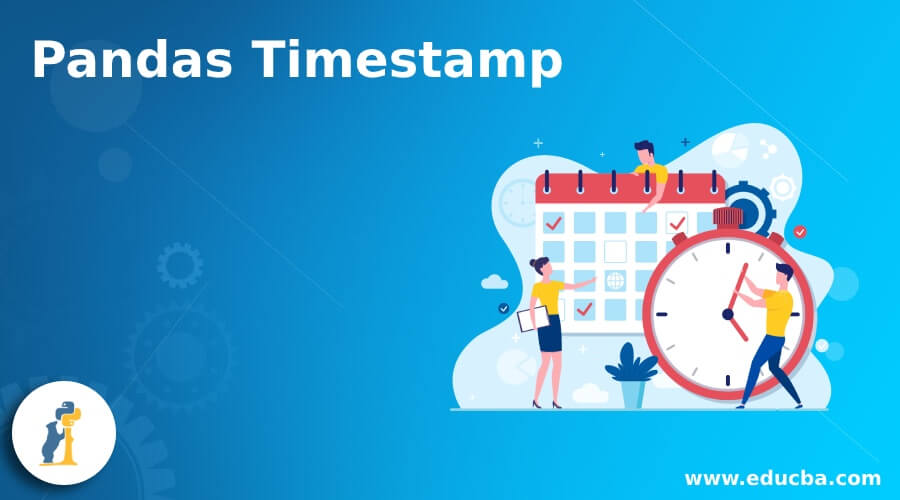Updated April 20, 2023

Introduction to Pandas Timestamp
Pandas Timestamp work return time object with same time yet with tzinfo equivalent to None. Python is an extraordinary language for doing information investigation, principally as a result of the fabulous biological system of information driven python bundles. Pandas is one of those bundles and makes bringing in and investigating information a lot simpler. In the broadest definition, a period arrangement is any informational collection where the qualities are estimated at various focuses in time. Many time arrangements are consistently separated at a particular recurrence.
Syntax and Parameters:
Pandas.Timestamp()- Parameters are none and returns the datetime object.
How Timestamp Function works in Pandas?
Given below shows few examples on how timestamp function works in Pandas:
Example #1
Using timestamp function to return the timestamp object.
Code:
import pandas as pd
t = pd.Timestamp(year = 2002, month = 9, day = 13, hour = 6, second = 33, tz = 'US/Central')
print(t)Output:
In the above program, we first import pandas as pd and then create a dataframe of the timestamp and assign it to variable t. Now we declare all the parameters that this timestamp should contain such as year, month, day, seconds and the timezone which we need to implement the code to. Now we utilize the timestamp function to print this and the output is as shown in the above snapshot.
Example #2
Using timestamp function to return the time.
Code:
import pandas as pd
t = pd.Timestamp(year = 2002, month = 9, day = 13,
hour = 6, second = 33, tz = 'Europe/London')
t.time()
print(t.time())Output:
In the above program, similar to the previous program, we import first the pandas library. After importing the pandas library, we create a dataframe timestamp and add the necessary credentials. After this process, we use the timestamp function to return the time and the output is as shown in the above snapshot.
Example #3
Using timestamp function to display the datetime.
Code:
import pandas as pd
t = pd.Timestamp(2002, 3, 13, 6)
print(t)Output:
In the above program, we first import pandas as pd and then define a timestamp and define the parameters. Finally, we display the day and time and the output is as shown in the above snapshot.
Initially produced for budgetary time arrangement, for example, day by day securities exchange costs, the hearty and adaptable information structures in pandas can be applied to time arrangement information in any space, including business, science, designing, general well being, and numerous others. With these instruments you can without much of a stretch arrange, change, break down, and imagine your information at any degree of granularity by inspecting subtleties during explicit time frames of intrigue, and zooming out to investigate minor departure from various time scales, for example, month to month or yearly collections, repeating designs, and long haul patterns.
Time arrangement can likewise be sporadically dispersed and irregular, for instance, timestamped information in a PC framework’s occasion log or a background marked by 911 crisis calls. Pandas time arrangement instruments apply similarly well to either sort of time arrangement.
In case we are managing a succession of strings all in a similar date/time position, we can unequivocally determine it with the configuration boundary. For exceptionally huge informational indexes, this can extraordinarily accelerate the exhibition of datetime() contrasted with the default conduct, where the configuration is surmised independently for every individual string. Any of the arrangement codes from the strftime() and strptime() capacities in Python’s worked in datetime module can be utilized. The model beneath utilizes the arrangement codes %m (numeric month), %d (day of month), and %y (2-digit year) to determine the organization.
To work with time arrangement information in pandas, we utilize a DatetimeIndex as the list for our dataframe or Series. One of the most impressive and helpful highlights of pandas time arrangement is time sensitive ordering utilizing dates and times to naturally compose and get to our information. With time sensitive ordering, we can utilize date/time arranged strings to choose information in our dataframe with the loc accessor. The ordering works like standard mark based ordering with loc, yet with a couple of extra highlights.
Another exceptionally convenient component of pandas time arrangement is fractional string ordering, where we can choose all date or times which somewhat coordinate a given string.
Conclusion
Finally, we would like to conclude by saying that in pandas, a single point in time is represented as a Timestamp. We can use the datetime() function to create Timestamps from strings in a wide variety of date/time formats. On the off chance that we flexibly a rundown or exhibit of strings as contribution to datetime(), it restores a succession of date or time esteems in a DatetimeIndex object, which is the center information structure that powers quite a bit of pandas time arrangement usefulness.
Recommended Articles
We hope that this EDUCBA information on “Pandas Timestamp” was beneficial to you. You can view EDUCBA’s recommended articles for more information.

